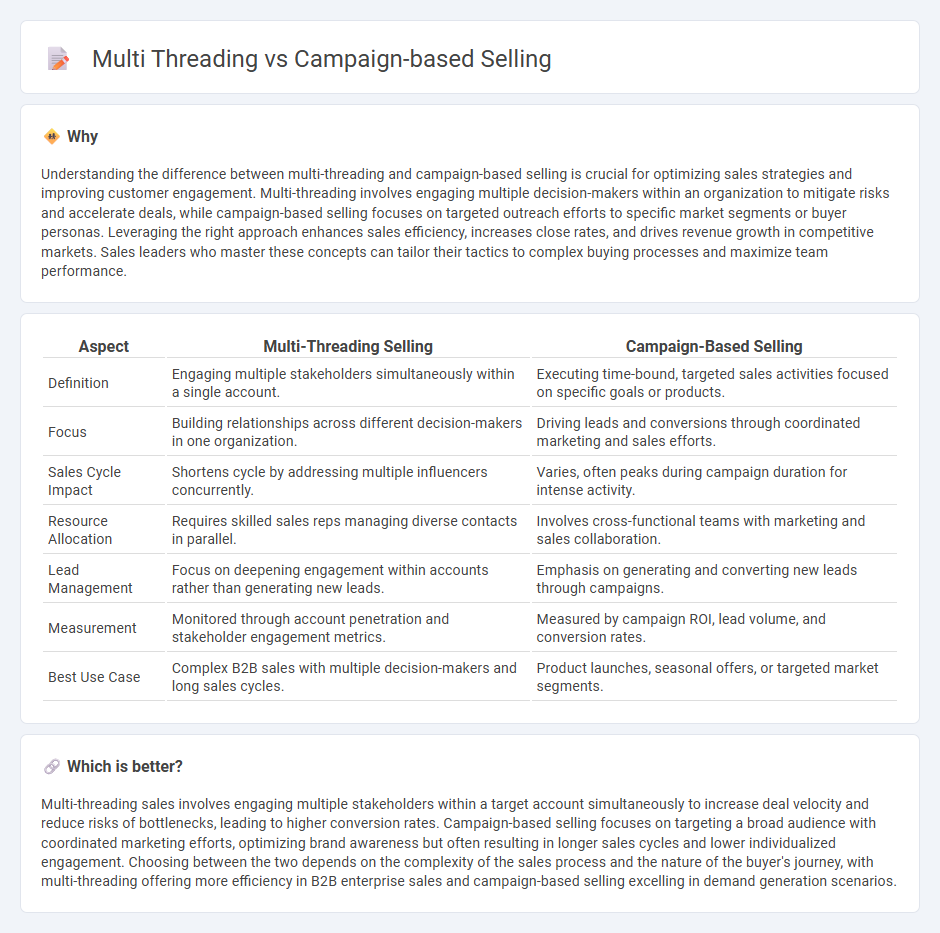
Multi-threading in sales involves engaging multiple stakeholders within a target organization to increase deal success, contrasting with campaign-based selling that targets a broad audience through structured marketing efforts. Multi-threading enhances relationship depth and reduces reliance on a single contact, while campaign-based selling leverages scale and consistent messaging for lead generation. Explore how integrating these strategies can optimize sales performance and accelerate revenue growth.
Why it is important
Understanding the difference between multi-threading and campaign-based selling is crucial for optimizing sales strategies and improving customer engagement. Multi-threading involves engaging multiple decision-makers within an organization to mitigate risks and accelerate deals, while campaign-based selling focuses on targeted outreach efforts to specific market segments or buyer personas. Leveraging the right approach enhances sales efficiency, increases close rates, and drives revenue growth in competitive markets. Sales leaders who master these concepts can tailor their tactics to complex buying processes and maximize team performance.
Comparison Table
| Aspect | Multi-Threading Selling | Campaign-Based Selling |
|---|---|---|
| Definition | Engaging multiple stakeholders simultaneously within a single account. | Executing time-bound, targeted sales activities focused on specific goals or products. |
| Focus | Building relationships across different decision-makers in one organization. | Driving leads and conversions through coordinated marketing and sales efforts. |
| Sales Cycle Impact | Shortens cycle by addressing multiple influencers concurrently. | Varies, often peaks during campaign duration for intense activity. |
| Resource Allocation | Requires skilled sales reps managing diverse contacts in parallel. | Involves cross-functional teams with marketing and sales collaboration. |
| Lead Management | Focus on deepening engagement within accounts rather than generating new leads. | Emphasis on generating and converting new leads through campaigns. |
| Measurement | Monitored through account penetration and stakeholder engagement metrics. | Measured by campaign ROI, lead volume, and conversion rates. |
| Best Use Case | Complex B2B sales with multiple decision-makers and long sales cycles. | Product launches, seasonal offers, or targeted market segments. |
Which is better?
Multi-threading sales involves engaging multiple stakeholders within a target account simultaneously to increase deal velocity and reduce risks of bottlenecks, leading to higher conversion rates. Campaign-based selling focuses on targeting a broad audience with coordinated marketing efforts, optimizing brand awareness but often resulting in longer sales cycles and lower individualized engagement. Choosing between the two depends on the complexity of the sales process and the nature of the buyer's journey, with multi-threading offering more efficiency in B2B enterprise sales and campaign-based selling excelling in demand generation scenarios.
Connection
Multi-threading in sales involves engaging multiple decision-makers within a target organization to ensure a higher chance of deal success. Campaign-based selling leverages this by tailoring coordinated outreach efforts to various stakeholders simultaneously, increasing engagement and alignment. Combining multi-threading with campaign-based strategies enhances lead nurturing, shortens sales cycles, and improves conversion rates.
Key Terms
**Campaign-based selling:**
Campaign-based selling targets specific customer segments through tailored marketing efforts and timed promotional campaigns, optimizing lead generation and conversion rates. It leverages data analytics to personalize messages and track customer engagement across channels, enhancing ROI. Explore deeper strategies and benefits of campaign-based selling to boost your sales performance.
Targeted Outreach
Campaign-based selling employs structured sales efforts aimed at specific customer segments through coordinated marketing actions to maximize engagement and conversion rates. Multi-threading involves building relationships with multiple stakeholders within the same organization to navigate complex buying processes, enhancing deal success and reducing sales cycle time. Discover how integrating targeted outreach with multi-threaded strategies can elevate your sales performance.
Promotional Cadence
Campaign-based selling relies on structured promotional cadences to deliver targeted messages at specific intervals, optimizing customer engagement and conversion rates. Multi-threading involves simultaneous interactions with multiple stakeholders within an organization, ensuring consistent messaging and fostering deeper relationships across departments. Explore the nuances of promotional cadence in both strategies to enhance your sales effectiveness.
Source and External Links
Always-on vs. campaign-based marketing during uncertain times - Campaign-based selling is an agile, short-term marketing strategy focused on specific moments or seasonal events, requiring less commitment and allowing targeted, cost-effective campaigns that push consumers at the tipping point of purchase to buy products or services.
The Ideal Sales Campaign [Key Elements + Channels] - A sales campaign is a short-term strategic plan using specific sales tactics to quickly increase product/service sales, generate brand awareness, and meet sales targets by motivating sellers and incentivizing buyers.
The power of a campaign-based approach to marketing - Campaign-based selling uses multiple marketing touchpoints and consistent messaging across channels to efficiently engage potential buyers and generate viable sales leads because it usually takes several marketing contacts to drive a sale.
 dowidth.com
dowidth.com